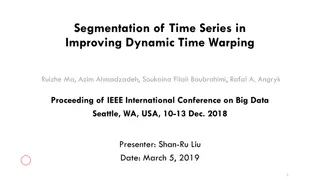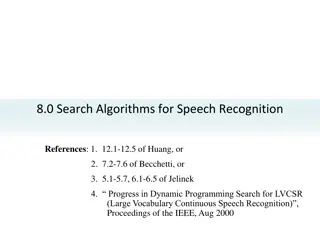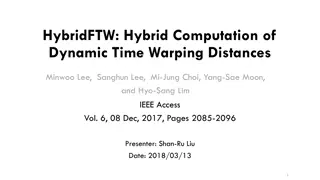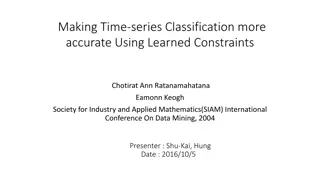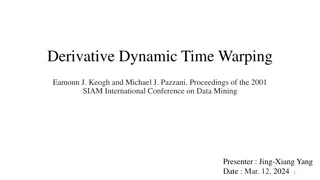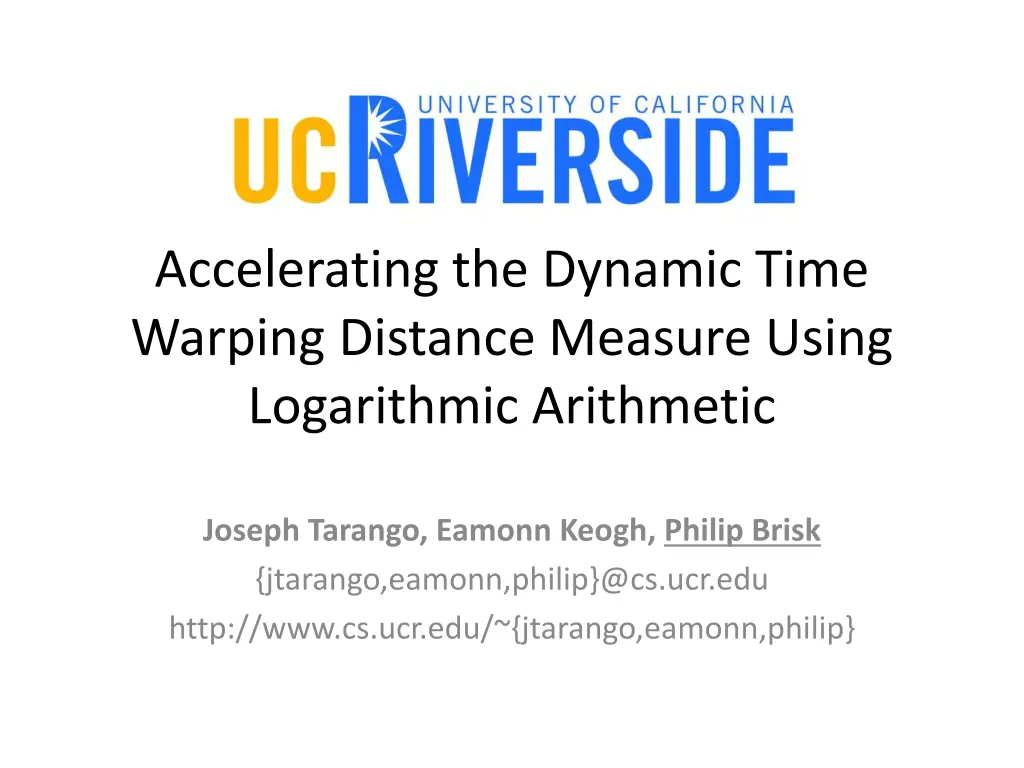
Accelerating Dynamic Time Warping Distance Measure with Logarithmic Arithmetic
"Learn how to accelerate the Dynamic Time Warping distance measure using logarithmic arithmetic for efficient time series analysis in healthcare. Explore the importance of real-time monitoring and detection in critical conditions like pericardial tamponade. Discover the conceptual idea and implementation of DTW for optimal solution computation. Uncover why DTW remains a key similarity search method in time series data mining, surpassing Euclidean distance measures." (Approximately 455 characters)
Download Presentation

Please find below an Image/Link to download the presentation.
The content on the website is provided AS IS for your information and personal use only. It may not be sold, licensed, or shared on other websites without obtaining consent from the author. If you encounter any issues during the download, it is possible that the publisher has removed the file from their server.
You are allowed to download the files provided on this website for personal or commercial use, subject to the condition that they are used lawfully. All files are the property of their respective owners.
The content on the website is provided AS IS for your information and personal use only. It may not be sold, licensed, or shared on other websites without obtaining consent from the author.
E N D
Presentation Transcript
Accelerating the Dynamic Time Warping Distance Measure Using Logarithmic Arithmetic Joseph Tarango, Eamonn Keogh, Philip Brisk {jtarango,eamonn,philip}@cs.ucr.edu http://www.cs.ucr.edu/~{jtarango,eamonn,philip}
Motivation 100% fatality rate if left untreated Influx of fluid raises the heart muscle s perfusion threshold Heart starves for oxygen and stops pumping blood Easy to treat Puncture pericardium and drain fluid Hard to detect People are not (yet?) born with integrated sensors Stringent real-time constraints between onset and death https://gs1.wac.edgecastcdn.net/8019B6/data.tumblr.c om/tumblr_loeis9vfDe1qi4jh5o1_400.jpg 2
Pulsus Paradoxus Normal Pulsus Paradoxus Respiration PPG (Photoplethysmographic) Pulse shows interference from respiration Under pericardial tamponade, inhalation reduces the heart s ability to pump blood Real-time detection is computationally tractable on a bedside device at the hospital We need more efficient solutions for real-time monitoring 3
Time Series (Formal Definition) Ordered sequence of data points T = (t1, t2, , tm) In the online context, consider a subsequence Ti,k = (ti, ti+1, , ti+k) Query Candidate C = Ti,k Q T 4
Time Series Similarity Euclidean Distance (ED) Dynamic Time Warping (DTW) 5
DTW Conceptual Idea: Enumerate all possible warping paths Choose the one of minimum cost C Q Implementation: Dynamic programming computes an optimal solution in quadratic time 6
The Case for DTW similarity search is the bottleneck for virtually all time series data mining algorithms. [SIGKDD 2012] After an exhaustive literature search of more than 800 papers [PVLDB 2008], we are not aware of any distance measure that has been shown to outperform DTW by a statistically significant amount on reproducible experiments. [SIGKDD 2012] We can exactly search under DTW much faster than the current state-of-the-art Euclidean distance search algorithms. [SIGKDD 2012] 7
Objective and Contribution Design application-specific DTW processor with HW acceleration Performance Energy consumption Start with highly optimized DTW software [SIGKDD 2012] Double-precision floating-point arithmetic written in C Prior work [CODES-ISSS 2013] DTW processor derived from SIGKDD software This talk: DTW processor using logarithmic number systems (LNS) Higher performance Reduced energy consumption Reduced area 8
Logarithmic Number System (LNS) Represent X as logX The good news log(XY) = logX + logY log(X/Y) = logX logY log(Xn) = nlogX log(X1/n) = (1/n)*logX (fixed-point +) (fixed-point -) (fixed-point *) (fixed-point /) The bad news log(X Y) = logX + log(1 2logB logA) Conversion to/from LNS (ROM) (log/exp) 9
LNS Operators Based on work by F. de Dinechin and J. Detrey [Asilomar 2003, 2005; ASAP 2005; DSD 2005; JMM 2006] 10
Z-Normalization C C C C Q Q Q Q Arithmetic Mean [SIGKDD 2012, CODES-ISSS 2013] Geometric Mean (Good for LNS) 11
Bounding Warp Paths and LB_Keogh C U Q Ui = max(qi-r : qi+r) Li = min(qi-r : qi+r) L Q Sakoe-Chiba Band C U 2 ( ) q ( U if q U i i i i n = = 2 _ Q ( , ) ) LB Keogh C q L if q L i 0 i otherwise i i 1 i L Q DTW < threshold ==> Match If LB_Keogh > threshold, then DTW > threshold No match ==> no need to compute DTW 12
Early Abandoning, Reordering and Reversing the Query/Candidate Standard early abandon ordering Optimized early abandon ordering 14 2 3 9 5 8 7 C C 6 5 1 24 3 Q Q Stop as soon as you exceed the threshold 13
Cascading Lower Bounds LB_KimFL A and D C O(1) Time A D LB_Kim A, B, C, D O(n) Time B 1 Early_abandoning_DTW max(LB_KeoghEQ, LB_KeoghEC) Tightness of lower bound DTW Tightness of lower bound LB_FTW LB_KeoghEQ LB_Ecorner LB_KimFL LB_Yi LB_PAA LB_Kim 0 O(1) O(nR) O(n) 15
Experimental Platform Microblaze Processor 1 core, 100 MHz Integer divider 64-bit multiplier 2048-bit branch target cache Xilinx EK-V6-ML605-G Cache Configuration 16
ISE I/O Interface MicroBlaze operates on 32-bit data Double-precision FP / LNS use 64-bit data 2 cycles to transfer each operand to/from the ISE 17
Software Profile Four instruction set extensions ISE-Norm (Normalization) ISE-DTW (DTW) ISE-ACCUM (Accumulation) ISE-ED (Euclidean Distance) [CODES-ISSS 2013] 18
FP vs. LNS Operators and ISEs Latency FP 40 LNS 35 30 25 20 15 10 5 0 ADD/SUB ADD/SUB MUL MUL DIV DIV ISE-Norm ISE-Norm ISE-DTW ISE-DTW ISE-ACCUM ISE-Accum ISE-ED ISE-ED ALU Ops ISEs ISEs ALU Ops LNS operator latency is dominated by data transfer overhead FP operator latency is dominated by the operator 19
FP vs. LNS Operators and ISEs Area (FPGA Resources) 14000 12000 10000 8000 6000 4000 2000 0 FP LNS FP LNS FP LNS FP LNS FP LNS FP LNS FP LNS ADD/SUB ADD/SUB MUL MUL DIV DIV ISE-Norm ISE-Norm ISE-DTW ISE-DTW ISE-ACCUM ISE-Accum ISE-ED ISE-ED ALU Ops ISEs ISEs ALU Ops LUT FFs Slice LUTs Slice Regs LNS operators are significantly smaller 20
Speedup (Normalized to Baseline MicroBlaze) 10 9 8 7 6 5 4 3 2 1 0 1 ISE 2 ISEs 3 ISEs 4 ISEs 1 ISE 2 ISEs 3 ISEs 4 ISEs Baseline Baseline + FPU Baseline + FP ISEs Baseline + LNS ISEs gcc at optimization level O3 used for all experiments FP ISE operators are pipelined LNS-based ISEs offer higher performance than FP ISEs 21
Energy Consumption (Joules) 10000 7500 5000 2500 0 Baseline Baseline Baseline + FPU Baseline + FPU Baseline + FP ISEs Baseline + FP ISEs Baseline + LNS ISEs Baseline + LNS ISEs gcc O3 used in all experiments reported here 22
Conclusion and Future Work LNS vs. Floating-point Instruction Set Extensions for DTW Processor Faster (8.7x vs. 4.9x) More energy efficient (8.5x vs. 4.7x) Cheaper (FP ISEs are 3.6x larger than LNS) Future Work Vary the precision of arithmetic operators Scale up the system More candidates More queries More cores (more ISEs? shared ISEs? Etc.) 23

